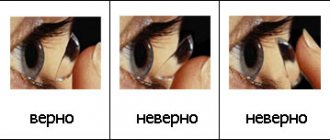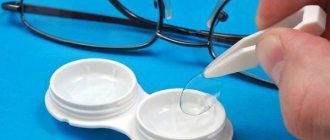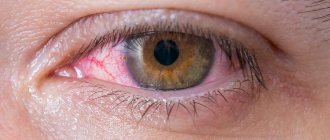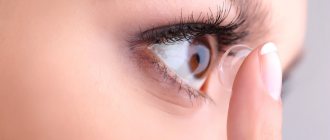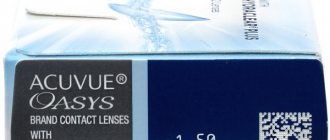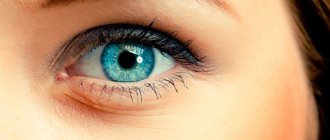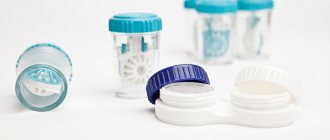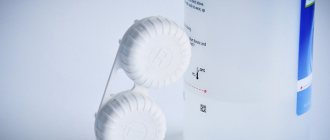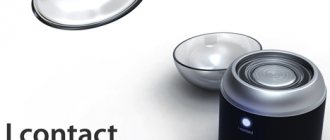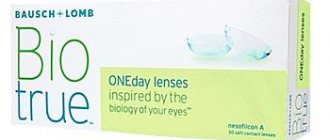Home Articles Articles about lenses Contact lenses: what are they? Expiration date, wearing period and wearing mode of contact lenses: how to figure out what the difference is?
Published:
Back to archive
Most people believe that contact lenses have no expiration date and can be worn as long as their vision remains clear, but this is completely wrong! Soft contact lenses have an expiration date, after which their use becomes unsafe for eye health.
There are certain rules and terms for using contact lenses, strict adherence to which will preserve eye health and ensure eye comfort in contact lenses and clear vision in them.
Types of contact lenses by wearing period
As mentioned above, the wearing period determines the permissible period of use of contact lenses. It must be counted from the moment the packaging was broken. Sometimes this period turns out to be less than what the manufacturer indicated. A signal that it is time to replace your lenses is discomfort that occurs while wearing them. In addition, it is necessary to purchase a new pair in case of deformation or damage to the lens.
Depending on the period of wearing, there are:
You may be interested in: Storing and caring for contact lenses
1) Traditional lenses; 2) Quarterly lenses; 3) Planned replacement lenses; 4) Frequently scheduled replacement lenses; 5) Daily replacement lenses.
Traditional lenses
Traditional lenses last from six months to nine months. They contain materials that are optimal for long-term wear. The care of such lenses is carried out using tablets that are added to the universal solution.
Quarterly lenses
Quarterly lenses need to be changed every three months. They are made of a material with a perfectly smooth surface, which makes them comfortable for the eyes.
Planned replacement lenses
The wearing period for scheduled replacement lenses is one month, and some types can be worn throughout their entire service life without removal. This is indicated by a note about the mode of wearing lenses, which will be discussed below. Of all the lenses available on the shelves, this category is in greatest demand among buyers. The relatively short wearing period makes them much easier to care for. It is enough to simply disinfect them in a universal solution.
Frequently scheduled replacement lenses
Frequently scheduled replacement lenses require replacement every one to two weeks. The materials that were used to make them contain a large amount of moisture, which ensures safe wearing and minimizes the risk of complications.
Daily replacement lenses
Daily replacement lenses, as the name implies, serve their owner for only 1 day. This type of contact vision correction is the safest for the eyes. At the end of the day, the used pair is thrown away and a new one is put on in the morning. Changing lenses daily ensures maximum wearing comfort. This type of contact lens is ideal for people with allergies to substances contained in cleaning solutions. In addition, they are perfect for those who wear lenses only occasionally.
The manufacturer places each lens in a separate plastic container with a special solution. The foil used to hermetically seal the package ensures the sterility of the contents. The wearing period of lenses must be counted from the moment the original packaging is opened. Once the packaging is broken, using the original container to store contact lenses is strictly prohibited.
After breaking the packaging, the lenses must be placed in a special container, which can be purchased at any ophthalmology store. To disinfect lenses, use a special lens liquid. Most manufacturers of all-in-one contact lens solution sell lens cases included with the solution.
You may be interested in 1 Day Acuvue Trueye lenses
When worn, fats, proteins, and dirt (for example, cosmetics or dust) accumulate on the surface of contact lenses. In addition, the composition of the tear also affects the rate at which deposits accumulate. This parameter is purely individual and is determined by a number of factors. So, it directly depends on a person’s nutrition, on the functioning of the secretion glands, on the composition of the air and, of course, on how well the patient observes the rules of personal hygiene.
It is for this reason that an ophthalmologist conducts a thorough examination before recommending a particular type of contact lens to a patient.
Do IOLs have an expiration date?
According to experts, such lenses can last 200 or 300 years. This cannot be verified experimentally. However, there are no products that are intended, for example, for 10 or 20 years of wear. The artificial lens is permanent, even if it is implanted in a newborn with cataracts who will live a very long life.
There are cases when it is necessary to replace the IOL, but they are not associated with the quality of the lens or its shelf life, but with complications that arise after the lens removal procedure. We are talking about the displacement of the product in the capsule. This can happen if there is an eye injury. The defect is corrected through surgery. The optical properties of the IOL may deteriorate with the development of secondary cataracts, which are caused by the remains of fibrous tissue in the lens capsule. This disease is treated with laser dissection.
All these nuances must be provided for in the contract that the patient enters into with the clinic. If complications occur, the quality characteristics of the implant may deteriorate. Whether the lens is replaced at the hospital's expense or at the customer's expense depends on the specific hospital.
MagazinLinz.ru team
Types of contact lenses depending on wearing mode
The wearing mode determines the maximum permissible duration of wearing lenses without interruption for disinfection.
The following wearing modes are distinguished:
1) Daytime; 2) Flexible; 3) Prolonged; 4) Continuous wearing.
Day mode
Daytime wearing allows contact lenses to be used during the day, followed by their removal and disinfection. Wearing duration is from 10 to 12 hours. The packaging of contact lenses of this type is marked DW.
Flexible mode
Flexible wearing sometimes allows the patient to sleep in the lenses, but it is not advisable to repeat this for more than three nights in a row. The FW mark indicates that the lenses belong to this type.
Extended Mode
Extended wear lenses allow the patient to wear them continuously for a week. After 7 days you need to take a break. Manufacturers leave the EX mark on the packaging of such lenses.
Continuous wearing
Continuous wear lenses can be worn without interruption for a month (that is, not removed for disinfection). The possibility of wearing them for a long time is due to the material, which allows oxygen to pass through well. Manufacturers leave the CW mark on the packaging of such lenses.
Using lenses in excess of the permissible norm may cause the patient to experience a number of unpleasant symptoms, such as itching, redness, inflammation of the eyes or dryness. This is due to the fact that when the permissible time is exceeded, the level of moisture decreases, the lenses transmit oxygen worse and become less resistant to dirt.
Why can't you wear contact lenses?
If you see on the packaging that the lenses can be worn for exactly 30 days, then this does not mean that the product can only last for this period. This is the time after which the manufacturer recommends replacement. That is why it is not recommended to overwear the products, even if you do not feel any discomfort.
Even when providing high-quality care, remember that the material may lose its properties. If you replace your old lenses, then you will probably notice that the quality of your vision has improved. When your lenses expire, you may feel more than just discomfort. Sometimes the consequences can be quite serious.
It is important to know! If the manufacturer indicated a date and you notice that it is expired, then before using such lenses they will need to be treated with appropriate products. If this is not done, then the use of the product is prohibited.
What are the dangers of wearing lenses beyond the specified period?
As soon as the wear period recommended by the manufacturer has expired, you must immediately purchase a new pair. Under no circumstances should you wear lenses beyond the specified period, even if there is no discomfort during wearing. It is strictly prohibited to independently extend the period of wearing contact lenses.
You may be interested in How to put on and take off lenses
This is primarily due to the fact that wearing expired lenses causes discomfort in the eyes. In addition, lenses that have expired can cause harm to the patient’s health. Thus, exceeding the wearing period may cause an allergic reaction or deterioration in visual acuity.
Despite daily cleaning of the lenses, dirt is still deposited on their surface and, by the end of the wear period specified by the manufacturer, the level of dirt becomes critical. This, in turn, creates favorable conditions for the proliferation of bacteria. Over time, microorganisms begin to accumulate on the surface of the lens and subsequently lead to the occurrence of inflammatory diseases.
Wearing contact lenses beyond the prescribed period is also dangerous because, as a result of deposits that accumulate on the surface of the lens, the eye receives insufficient oxygen. A constant lack of oxygen can cause swelling of the cornea and, as a result, the ingrowth of blood vessels into it. In the best case, the patient will have to stop wearing contact lenses for a while. At worst, you will have to forget about this method of vision correction forever.
Description of Acuvue Oasys two-week contact lenses from Jonson&Jonson
Inexpensive lenses Acuvue Oasys with Hydraclear Plus are the latest development of the American brand Johnson and Johnson. They provide high contrast and clarity of vision. Even when worn for a long time, they maintain a feeling of comfort and safety for the eyes.
Main characteristics
Made from modern silicone hydrogel material Senofilcon A. Oxygen permeability is 147 Dk/t, and thanks to the 38% moisture content, even with daily use there is no irritation or dry eyes. The thin surface with a thickness of 0.07 mm reduces friction and achieves natural movement of the eyelids during blinking. They are imperceptible on the iris, almost invisible to the naked eye.
How to avoid complications and dangerous consequences from wearing contact lenses
To ensure that wearing contact lenses is comfortable and does not lead to serious health consequences, you must follow the following rules:
1. Do not over-wear lenses during the day. It is necessary to strictly follow the recommendations of the manufacturer and ophthalmologist. 2. Do not sleep in contact lenses (with the exception of lenses whose descriptions allow you to leave them on at night). 3. Keep a calendar for purchasing contact lenses. This will allow them to be replaced in a timely manner. 4. If discomfort, redness, itching or other unpleasant symptoms occur, you should immediately consult a doctor.
What determines the service life of an intraocular lens?
An IOL is an ophthalmic product that resembles a regular contact lens. It is installed in the lens capsule after its removal and performs its functions. Modern intraocular lenses are made primarily from soft hydrogel materials. Acrylic and silicone polymers are also used in production. The shelf life of IOLs depends on their properties.
However, they are all durable. The Alcon company, known in the world market for the production of contact products, conducted a study. To date, approximately 50 million IOL implantation operations have been performed. At the same time, there was not a single case when it was necessary to replace the lens due to deterioration of its properties due to the expiration of its service life.
The materials used in the manufacture of intraocular lenses do not corrode or rot. Moreover, they are not affected by water, salts, acids and enzymes that are produced in the human body. There are no factors that could reduce the quality of the IOL or affect its optical properties. There are models of such lenses equipped with ultraviolet filters. They also retain their functionality for many years.
How to wear
Acuvue Oasys can be used in an extended period. It lies in the fact that you can wear the lenses continuously without having to remove them. Scheduled replacement is required every week. Thanks to its high air and moisture content, the model is also suitable for flexible use. The mode involves removing the product at night; the service life with this method increases to two weeks from the moment the blister is opened. Cleaning is required after each removal; storage is permissible only in a special plastic container filled with a disinfectant solution.
About long-term soft lenses can be found in the article.
Is it possible to sleep in lenses?
The surface of Oasys 2-week lenses allows sufficient oxygen to pass through and also has a good moisture content. If you wear them for an extended period of time, you can sleep in them. It should be remembered that this method increases the likelihood of drying out and irritation of the mucous membrane. If you do not follow the rules of use and planned replacement, there is a risk of developing corneal dystrophy. Ophthalmologists recommend removing lenses at night, which not only increases the life of the product, but also ensures eye safety.
How to remove lenses correctly
Read about hard night lenses here.
conclusions
- Acuvue Oasys lenses are a vision correction product with a two-week wearing period. Suitable for flexible and extended use.
- They have high levels of breathability and moisture content. They have a wide range of optical powers. The surface thickness is 0.07 mm.
- Recommended for myopia and farsightedness. The manufacturer also produces a model for people with astigmatism.
- For care and storage, a container and a disinfectant solution for cleaning are required.
- Available in sealed blister packs. Depending on the configuration, the package contains from 3 to 24 pieces.
